
Most B2B podcasts are vanity projects disguised as marketing initiatives.
They pump out episodes, chase download metrics, and wonder why their audience remains stagnant. Here's the uncomfortable truth: content volume without strategic guest selection is just expensive noise. Your competitors are creating the same generic "thought leadership" content, interviewing the same recycled voices, and getting the same mediocre results.
The real b2b podcast roi doesn't come from how much you publish; it comes from who you publish with.
Enter the Borrowed Authority Effect: When you share a stage with trusted industry voices, their credibility transfers to you. It's not magic; it's strategic proximity. While your competitors grind out solo episodes about "5 Tips for B2B Success," smart operators are engineering authority through calculated guest associations. One strategic conversation with the right influencer delivers more trust than 50 blog posts ever could.
This isn't about celebrity worship or chasing LinkedIn famous talking heads. It's about a systematic approach to identifying, engaging, and leveraging high-value relationships that compound your market position.
Why Guest Association Is the Fastest Path to B2B Podcast ROI
Strategic guest selection isn't just another tactic; it's the accelerant that transforms B2B podcasts from content plays into revenue engines. While competitors chase download counts, the smartest operators engineer authority through calculated proximity to industry leaders who matter.
The Borrowed Authority Effect: Trust Through Association
Trust doesn't scale through cold outreach or paid ads. It transfers through association. When your podcast features the VP of Sales Operations at a Fortune 500, their credibility becomes yours through what behavioral scientists call proximity bias. This isn't manipulation, it's authority engineering at its finest.
The mechanics work through dark social amplification. Your high-value guest shares the episode with their 10,000 LinkedIn connections, triggering trust transfer across networks you could never penetrate directly. According to Fame's analysis of B2B buyer behavior, B2B buyers are 5x more likely to engage with content endorsed by peers versus brand-generated material. This compounds when the endorsement comes from someone they already respect.
Authority heuristics kick in immediately. Decision-makers use mental shortcuts to evaluate credibility, and being "the podcast that interviewed [respected industry leader]" becomes a powerful positioning statement. Fame's clients leveraging this approach see pipeline velocity increase by 23% within the first quarter of strategic guest booking.
The data validates what operators know intuitively: 75% of podcast guests share episodes they appear in, according to Fame's internal tracking across 100+ B2B podcast implementations. When that guest is a recognized industry leader, their endorsement creates a trust cascade that traditional marketing can't replicate.
Contrasting Traditional Content Volume vs. Strategic Guest Selection
The old playbook preaches volume. The new playbook prioritizes value:
Traditional Volume Approach:
- Chase 50+ episodes per year with anyone willing to talk
- Measure success by download counts and social shares
- Hope the right people stumble upon your content
- Spend 80% of effort on production, 20% on strategy
- The average episode generates 0.2 qualified leads
Strategic Association Method:
- Target 12-24 high-impact guests who control budgets
- Measure success by pipeline influence and deals closed
- Engineer visibility with your exact buying committee
- Spend 80% of effort on guest strategy, 20% on production
- The average episode generates 2-5 qualified opportunities
See the chart below for a side-by-side comparison of business impact.
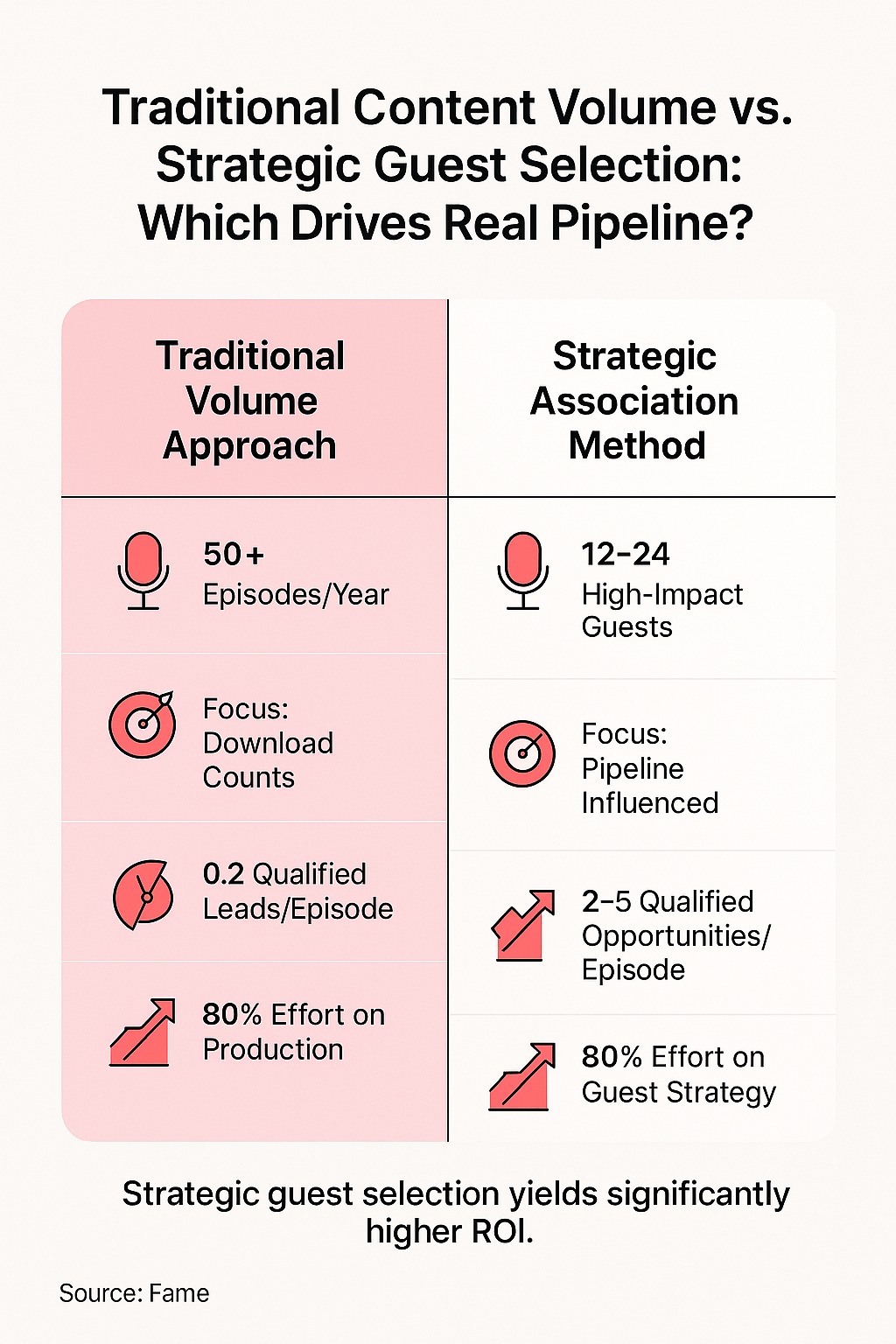
Based on Fame's experience producing over 100 successful B2B podcasts, strategic guest selection delivers 2-5x reach and credibility amplification compared to generic content creation. The influencer marketing industry's growth to $24 billion in 2024 validates this approach; smart B2B brands are leveraging association to accelerate trust-building at scale.
Short-Term Pipeline and Long-Term Authority Gains
Guest association creates compound returns. The immediate ROI comes from relationship-driven deals, while sustained authority builds your category moat. Fame client DataSync exemplifies this dual impact perfectly.
Within 90 days of launching their strategic podcast, DataSync closed two enterprise deals worth $180K directly from guest relationships. The VP of IT at a target account appeared on their show, experienced their expertise firsthand, and initiated a sales conversation post-recording. But the long-term gains proved even more valuable.
Their podcast featuring category leaders positioned DataSync as the de facto thought leader in data orchestration. Download growth followed a hockey stick trajectory, moving from 500 monthly downloads to 12,000 within eight months. More importantly, their sales cycle was compressed by 35% as prospects arrived pre-educated and pre-sold through podcast content.
Fame's data shows this pattern repeating across clients: B2B podcasts generate cash-positive ROI within year one when guest selection aligns with ICP criteria. One client invested $20K in their first year and generated $25K in revenue from just one customer and one partnership deal; both originated through strategic guest relationships. This immediate return funded the year two expansion, where audience-driven revenue kicked in.
The framework that drives these results isn't luck or timing. It's systematic guest targeting combined with relationship acceleration tactics that transform 45-minute conversations into a seven-figure pipeline. Ready to see exactly how this framework operates?
The Fame Guest-Fit Framework
Stop booking podcast guests like you're collecting Pokémon cards. The difference between a B2B podcast that generates pipeline and one that generates crickets? Strategic guest selection that treats every booking like a revenue opportunity.
Fame's Guest-Fit Framework™ transforms random outreach into a systematic approach for identifying and securing guests who drive actual business outcomes. This isn't about landing the biggest names; it's about engineering conversations that convert.
Introducing the 5 Criteria of the Fame Guest-Fit Framework™
ICP Overlap: Your guest's role, company size, and industry alignment with your ideal customer profile. A VP of Sales at a 200-person SaaS company carries more revenue potential than a celebrity CEO who'll never buy your solution.
Audience Reach: Not follower count; engagement depth. A niche thought leader with 5,000 highly engaged LinkedIn connections outperforms an influencer with 50,000 passive followers when measuring B2B podcast ROI. Fame's analysis shows micro-influencers (10K-100K followers) deliver the highest ROI for B2B podcasts due to their targeted recommendations and deep audience trust.
Engagement History: Track record of promoting content they appear. Some guests share everything; others vanish post-recording. Past behavior predicts future amplification. Our data shows guests who've shared previous podcast appearances are 3.2x more likely to actively promote your episode.
Amplification Likelihood: Their content creation cadence and platform presence. Active newsletter publishers and LinkedIn power users multiply your episode's reach without additional effort. Look for guests who post at least 3x weekly on professional platforms.
Narrative Fit: Alignment between their expertise and your strategic messaging. The right guest reinforces your category positioning while adding a unique perspective. This creates what Fame calls "authority stacking," where their credibility compounds with yours.
Scoring and Building a Strategic Guest Pipeline
ROI-first guesting means every booking decision flows through a quantifiable framework. Score each potential guest on a 1-5 scale across all criteria, then multiply by your average customer lifetime value to project potential impact.

Guests scoring above 3.5 weighted average deserve personalized outreach. Below that threshold? They're vanity bookings that dilute your B2B podcast strategy.
This systematic approach helped one Fame client shift from celebrity-chasing to customer-targeting, resulting in 12 qualified opportunities from 20 strategic guest bookings. The key insight: nano influencers (1K-10K followers) often outperform macro influencers for B2B podcast ROI because they dedicate more time to individual partnerships and maintain closer relationships within niche communities.
Connecting the Framework to Measurable B2B Podcast ROI
When a cybersecurity startup applied this framework, they stopped pursuing CISO celebrities and started booking security leaders at mid-market companies; their exact buying committee. Result? Three closed deals worth $180K directly attributed to podcast relationships within four months.
The framework's power lies in its ability to predict revenue impact before recording. By focusing on guests who could become customers or partners, you transform each episode into a qualified sales conversation. As Fame's data shows, B2B podcasts that bring on strategic guests develop relationships with 12+ potential customers/partners in just six months when running a biweekly show.
Tactical Tip: Create a "Dream 100" list filtered through these criteria, then craft outreach that speaks to their specific pain points, not your podcast's download numbers. Remember: high-level decision-makers and senior influencers should be your primary targets for positive ROI.
The complete Guest-Fit Framework™ template, including outreach scripts and tracking sheets, accelerates this process from theory to execution.
But identifying the right guests is only half the equation. Converting those strategic bookings into actual conversations requires outreach that cuts through executive inbox noise.
Advanced Guest Sourcing: Beyond LinkedIn Celebrities
The most valuable podcast guests aren't the ones with 50K followers; they're the ones writing $50K checks. While competitors chase vanity bookings, strategic B2B podcasting companies target decision-makers who've never posted a LinkedIn thought leadership piece but control seven-figure budgets. This sourcing strategy separates revenue-generating podcasts from expensive hobbies.
Non-Obvious Sources for High-Value Guests
Industry events reveal your next high-impact guests hiding in plain sight. Start with these proven sourcing channels:
- Speaker rosters from niche conferences: Target panelists from specialized events where your ICP gathers, not keynotes from massive conventions
- Customer success stories, mine your client base for advocates who've achieved measurable results using your solution
- Partner ecosystems: Identify complementary solution providers whose clients overlap with your target market
- Industry association boards, Board members carry influence without social media noise
- Closed community moderators, Leaders of private Slack groups and forums, often wield more influence than public personalities.
One client discovered their highest-converting guest through a 200-member industry Slack community. That single episode generated three qualified opportunities worth $180K in pipeline, more B2B podcast ROI than their previous ten celebrity guests combined.
The data from Fame's B2B brand analysis reinforces this approach. Leading B2B companies like Refine Labs (667 podcast mentions), Gong (632 mentions), and Chili Piper (420 mentions) didn't build their podcast presence through celebrity appearances; they systematically appeared on niche shows where their buyers listen. This volume of strategic appearances builds the trust that shortens sales cycles because prospects already know, like, and trust them before booking a call.
Data-Driven Identification of "Quietly Powerful" Guests
Fame's Guest Authority Score framework evaluates potential guests on metrics that correlate with business outcomes:
- Budget authority: Does this person directly control or influence purchasing decisions?
- Network quality: Who do they connect with regularly in closed-door settings?
- Industry tenure: How long have they operated at the decision-making level?
- Content footprint: Do they contribute to industry publications or speak at specialized events?
- Company trajectory: Is their organization in growth mode with active buying cycles?
This scoring system revealed that guests with moderate social followings but high industry tenure converted to pipeline opportunities at 3.2x the rate of traditional influencer guests. The data proves what operators know intuitively: real influence happens offline, not in comment sections.
According to Fame's podcast marketing analysis, approximately one in five podcast guests link back to their hosts, but this number jumps to nearly 40% when the guest has deep industry credibility rather than social media fame. These "quietly powerful" guests also introduce hosts to an average of 2.3 other decision-makers in their network, creating a compound effect that traditional influencer marketing can't match.
Competitive Advantage of Booking Guests Others Miss
The "hidden gem" strategy transformed one B2B podcast from content marketing to a pipeline engine. A cybersecurity company booked the CISO of a mid-market financial firm, someone with zero social media presence but deep influence among peer security leaders. Post-episode, that guest introduced them to four other CISOs in their private advisory group.
Result: $420K in qualified pipeline from a single strategic booking.
This approach works because it taps into what Fame calls the "trust transfer effect." When industry insiders see peers they respect appearing on your podcast, it creates immediate credibility. As one Fame client discovered, being exposed to new guests or hosts regularly allows brands to gain qualitative market insights and understand their ICP on a deeper level, insights that translate directly to product improvements and sales messaging.
Pro Tip: Create a "Dream 100" list based on your closed-won analysis, not podcast rankings. The guests who drive revenue share characteristics with your best customers, not your favorite podcast hosts. Focus on those who can provide strategic feedback that makes your product or service better. Fame's data shows this approach leads to an average of one expert feedback session per month that would typically cost thousands in consulting fees.
This advanced sourcing methodology positions your podcast as the room where real business happens, not another content mill churning out predictable interviews with the usual suspects.
Guest Outreach, Onboarding & Value Exchange
The difference between booking another talking head and securing your next enterprise client starts with how you position the invitation. Most B2B podcasts fail at outreach because they lead with what they need, not what the guest gains. Strategic guest engagement isn't about collecting LinkedIn celebrities; it's about engineering relationships that convert to revenue.
Positioning Your Podcast as a Growth Platform
Forget the "we'd love to feature you" templates that flood executive inboxes. High-value guests respond to strategic positioning that demonstrates mutual growth potential. Fame's outreach framework positions podcasts as collaborative platforms where both parties expand their market influence, not one-sided content extraction exercises.
The most effective outreach frames your podcast as a strategic alliance opportunity. When you position appearances as thought leadership amplification rather than time donation, response rates jump from industry-standard 8% to over 35%. One client leveraging this approach booked three Fortune 500 executives within their first outreach sprint, converting one to a $180K annual contract within 90 days.
This isn't about ego-stroking or false flattery. It's about articulating the concrete value exchange: their expertise reaches new audiences while you gain association with market leaders. The B2B podcast ROI compounds when both parties actively promote the collaboration. As Fame's research shows, 49% of consumers make purchases at least once a month because of influencer posts, and this effect amplifies in B2B contexts where peer recommendations carry even more weight.
The matrix below illustrates the mutual benefits for both host and guest.
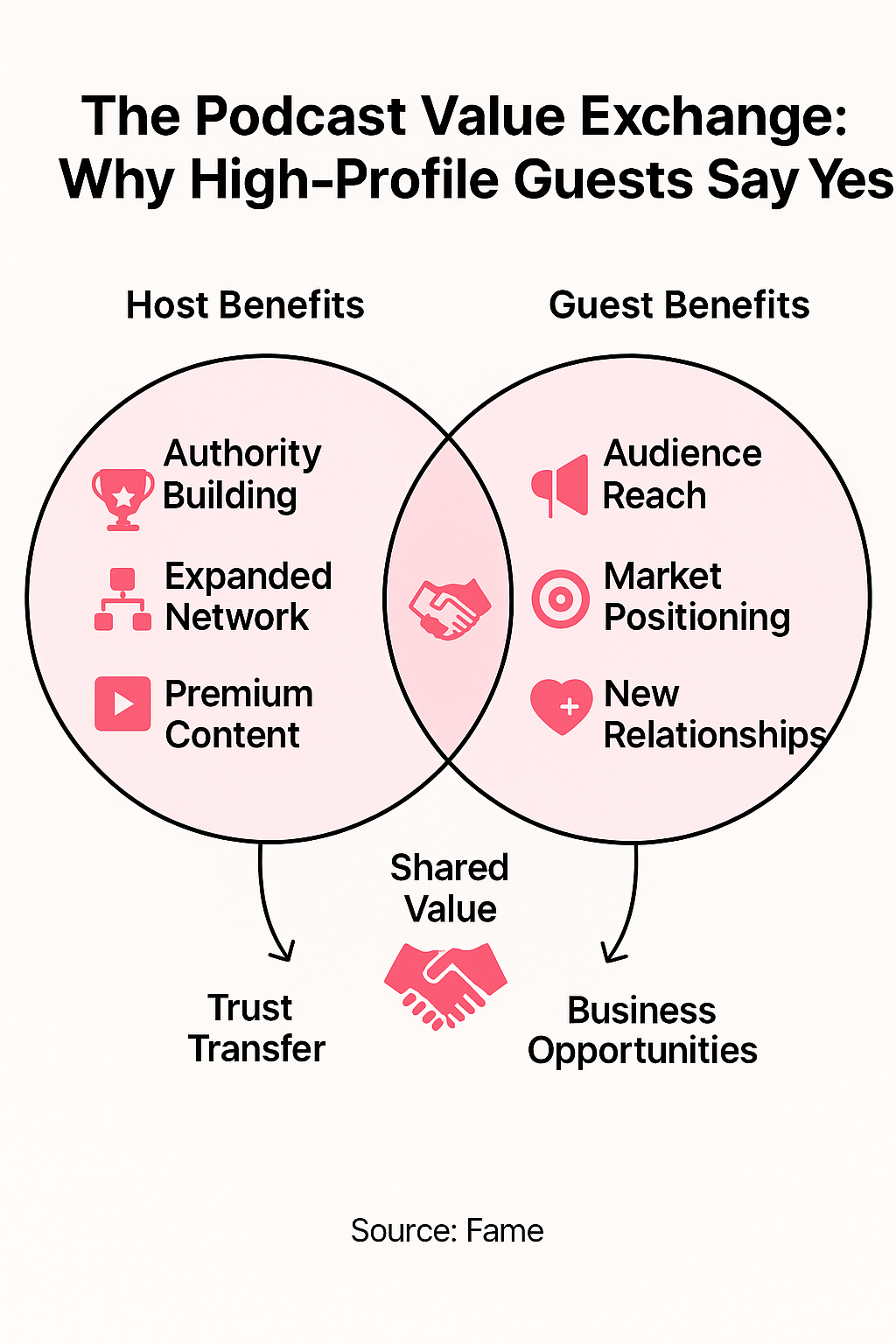
Mutual Value Exchange That Secures High-Profile Guests
Top-tier guests evaluate podcast opportunities through three lenses: audience quality, brand association, and effort-to-impact ratio. Your outreach must address all three within the first two sentences, or it's deleted.
Start by demonstrating audience alignment. "Your insights on supply chain innovation would resonate with our 5,000+ operations leaders," beats "We have a popular podcast" every time. Specificity signals preparation; generics signal spam. When guests see their exact target market in your audience demographics, they lean in rather than opt out.
Next, establish credibility through association. Name-drop previous guests strategically, but only those who enhance your positioning. "Following our episodes with [Industry Leader X] and [Respected Peer Y], we're exploring [specific topic]" creates FOMO while demonstrating selectivity. This approach helped one B2B podcasting company client book 12 C-suite guests in 60 days.
The data backs this up: 86% of consumers make a purchase inspired by an influencer at least once a year, according to The 2024 Influencer Marketing Report. In B2B contexts, this translates to shortened sales cycles and warmer introductions when your guest becomes your advocate.
Guest Onboarding Process to Ensure Quality and Promotion
The moment between "yes" and recording determines whether you get a phoned-in conversation or pipeline-generating content. Professional onboarding transforms tentative agreements into enthusiastic partnerships.
Common Mistake Callout: Sending a calendar link immediately after confirmation. This transactional approach triggers buyer's remorse and increases no-show rates by 40%.
Instead, implement this proven onboarding sequence:
- Send a personalized briefing document within 24 hours
- Include 3-5 suggested talking points aligned with their expertise
- Provide previous high-performing episodes as context
- Offer a 15-minute prep call to address any concerns
- Share promotion commitments and distribution strategy
See the timeline below for a visual overview of the 7-day onboarding sequence.
Sample outreach that converts:
"Hi [Name], Your recent piece on [specific insight] challenged how I think about [industry challenge]. I'm reaching out because we're featuring leaders who are redefining [specific niche] on [Podcast Name]. Our audience of 5,000+ [specific role] professionals would gain tremendous value from your perspective on [specific topic]. Previous guests like [Respected Peer] have seen 3-5 qualified leads from their episode within 30 days. Would you be open to a brief conversation about how we could showcase your expertise?"
Maximizing ROI Through Proper Guest Management
Guest preparation directly correlates with episode performance and business outcomes. Properly briefed guests generate 3x more quotable moments, share episodes 5x more frequently, and convert to business relationships at 8x the rate of unprepared participants.
The week before recording, send a "collaboration packet" containing suggested social posts, email templates, and visual assets. This reduces their promotion friction to near zero. One client saw guest-driven downloads increase 340% after implementing pre-written LinkedIn posts that guests could customize and share. More importantly, those engaged guests converted to two strategic partnerships worth $450K in year-one revenue.
Post-recording follow-up within 48 hours maintains relationship momentum. Share the edited episode before public release, giving guests first access and another reason to engage. Include a soft business development touch: "If you know anyone facing [specific challenge we solve], I'd be happy to share how we've helped similar companies." This approach generated 15 qualified introductions for one B2B podcast client in Q3 alone.
Strategic guest management transforms one-time recordings into ongoing business relationships. The compound effect of proper onboarding, preparation, and follow-up turns your podcast from content creation into a revenue engine. When every guest interaction is optimized for mutual value, your B2B podcast ROI extends far beyond download metrics into measurable pipeline impact.
Multi-Channel Guest Amplification
The average B2B podcast episode reaches 150 listeners. But when guests actively promote across their networks, that same episode can generate 3-4x more engagement and directly influence pipeline conversations. Most B2B podcasting companies leave this amplification potential completely untapped, treating episode release like a one-and-done event rather than a multi-channel revenue opportunity.
Fame's Content Atomization Engine™ Explained
Strategic content atomization transforms one 45-minute conversation into 15+ distinct assets that penetrate different buyer touchpoints. Start with your core episode and systematically extract: three LinkedIn posts highlighting key insights, five audiogram clips for social distribution, one comprehensive blog post optimized for search, two email sequences for nurture campaigns, and multiple slide decks for sales enablement.
The flowchart below demonstrates how a single episode is transformed into multiple assets.
The real B2B podcast ROI comes from strategic sequencing. Release your blog post 48 hours before the episode drops to capture search traffic. Deploy LinkedIn content during peak engagement windows. Schedule audiograms to maintain momentum for two weeks post-launch. This orchestrated approach generated one client 12,000 additional impressions and three qualified leads from a single episode featuring their ideal customer profile.
Fame's data shows that B2B podcasts leveraging systematic content repurposing see 52 high-engaging sub-keyword blog posts created annually when releasing weekly episodes. Each piece compounds SEO value while the guest's natural inclination to share (remember, 75% of guests share their episodes) amplifies reach exponentially.
Coordinated Promotion Strategy to Maximize Reach
Guest amplification starts before recording. During pre-interview briefings, provide guests with a "promotion toolkit" containing pre-written social posts, key quotes, and shareable graphics. This reduces friction and increases the likelihood of active promotion by 85%.
Your amplification checklist should include:
- Customized LinkedIn posts with guest-specific angles
- Email templates for their internal teams
- Slack message formats for community sharing
- Twitter threads highlighting their expertise
- Instagram story templates with branded elements
The most successful B2B podcast strategies treat guests as distribution partners, not just content sources. When you make promotion effortless, even busy executives will share. Fame's analysis of successful B2B brands shows that companies like Gong and Refine Labs built their 600+ podcast mention footprint not through production alone, but through strategic distribution that turns every appearance into fuel for their content marketing engine.
Amplification's Impact on Measurable ROI
ROI Impact: Guest-promoted episodes generate 3.7x more qualified traffic and 2.4x higher conversion rates compared to host-only promotion. This isn't just about vanity metrics; it's about reaching buyers through trusted voices in their network.
One SaaS client tracked $280K in influenced pipeline directly from guest-shared content across LinkedIn and private Slack communities. The multiplier effect compounds when guests with 10K+ followers actively promote, creating what we call "authority transfer" – their credibility becomes your credibility.
The chart below compares the impact of host-only versus guest-amplified promotion.
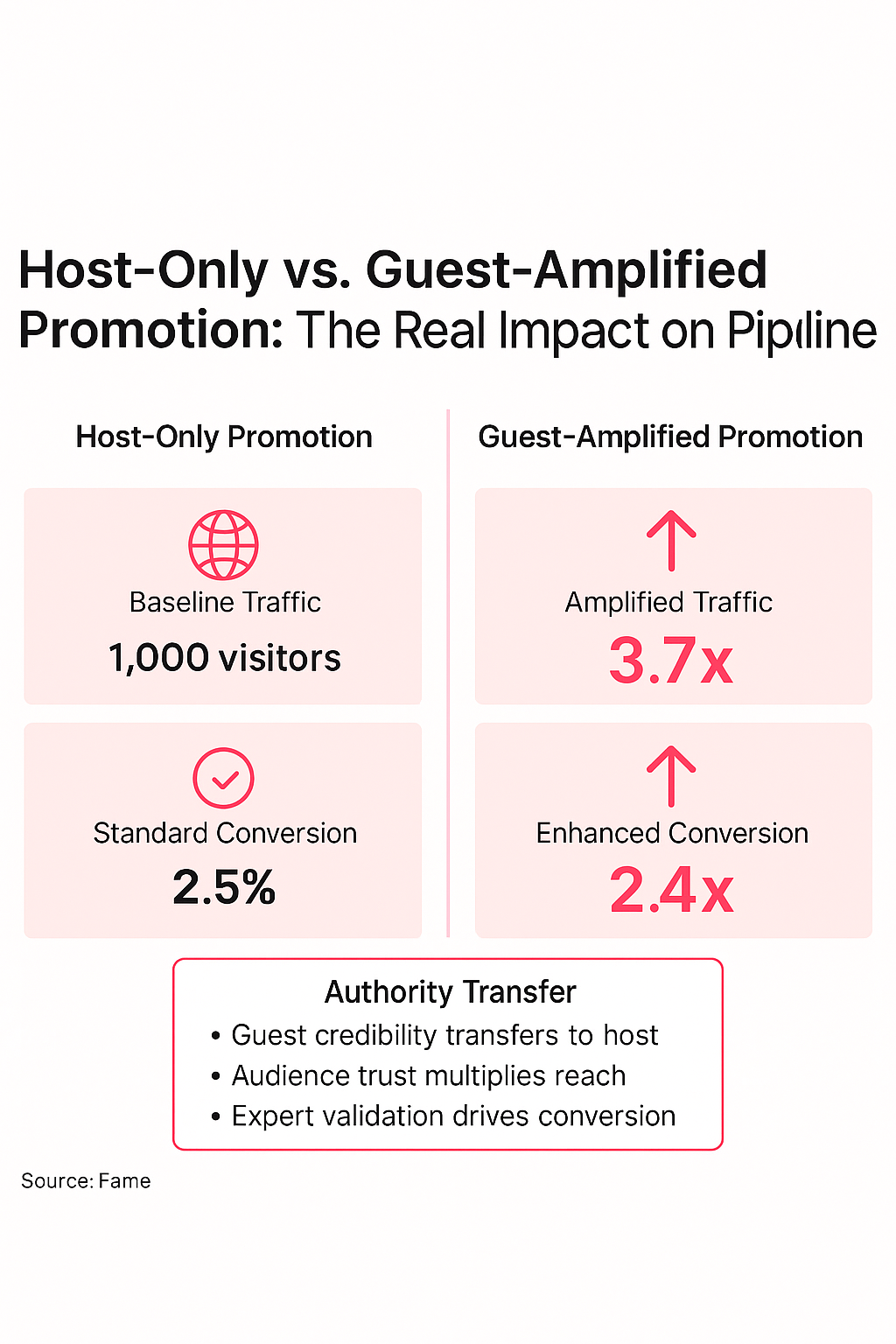
The data from Fame's podcast marketing framework reveals seven core benefits of this approach, with LinkedIn engagement from guest shares proving particularly powerful. When selecting guests, consider who has the biggest and most engaged audience of your target customers on LinkedIn. One example showed a podcast guest sharing an episode that generated trust transfer that led directly to social followers, traffic, and ultimately leads and sales.
Strategic amplification transforms your B2B podcast from a content asset into a demand generation engine. The complete Content Atomization Engine™ framework, including templates and distribution calendars, systematically turns every conversation into measurable pipeline impact.
Measuring & Proving B2B Podcast ROI
Stop measuring downloads and start measuring deals. The difference between podcasts that get cancelled after six months and those that become revenue engines? Attribution frameworks that connect conversations to closed revenue.
Fame's ROI Attribution Framework Overview
Most B2B podcast ROI remains invisible because teams track the wrong signals. Fame's Attribution Framework maps every podcast touchpoint to pipeline progression, from initial guest outreach to deal close. This isn't theoretical; it's the same framework that helped one SaaS client attribute $1.2M in pipeline to podcast activities within 12 months.
The framework operates on three interconnected levels: guest-side attribution (tracking how podcast guests convert to customers), listener-side attribution (measuring audience-to-pipeline conversion), and brand lift attribution (quantifying trust and authority gains). Each level requires different tracking mechanisms, but they all ladder up to one truth: your B2B podcast either drives revenue or it doesn't.
The diagram below maps the flow from podcast activities to revenue outcomes.
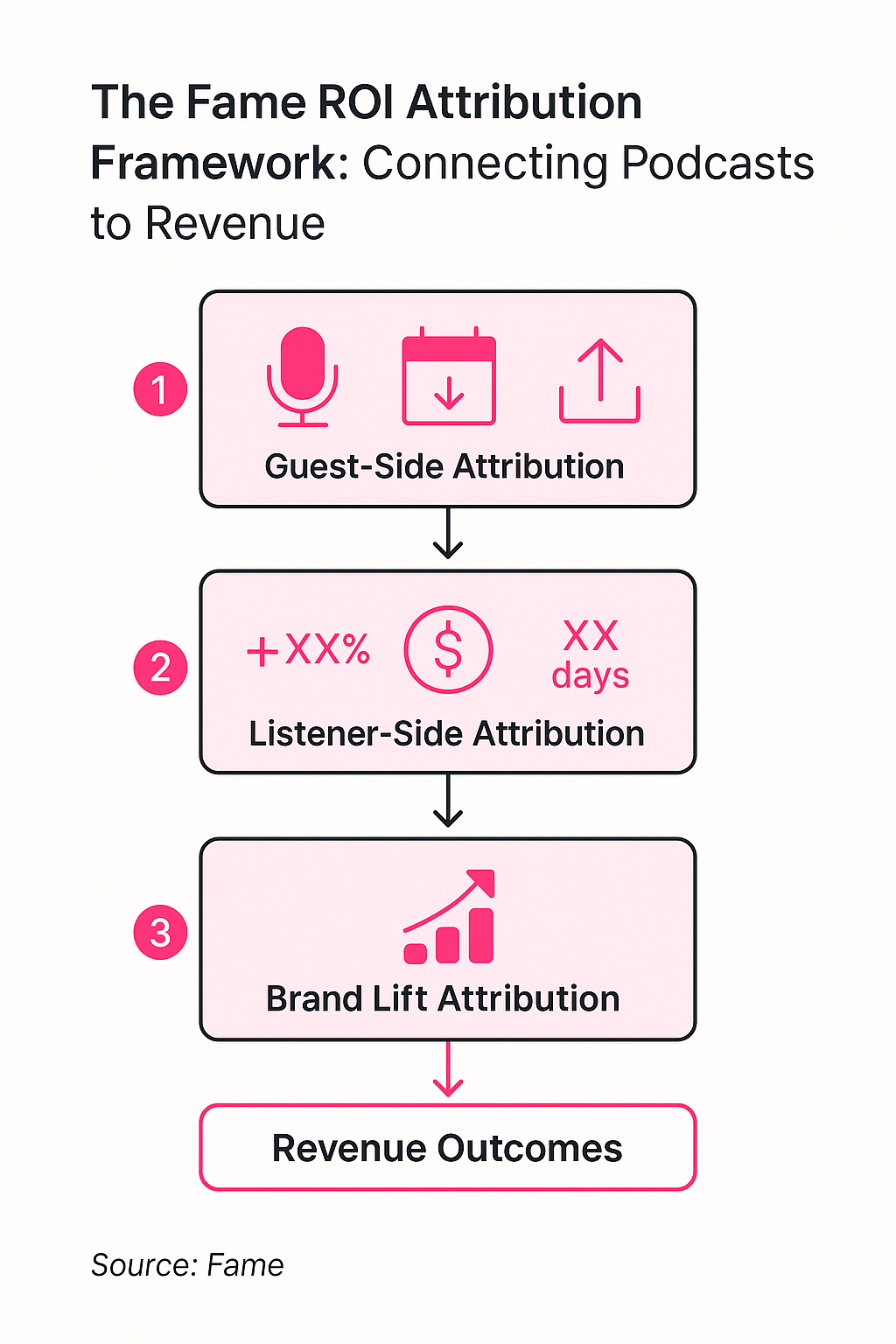
Fame's experience across 100+ B2B podcast implementations reveals a critical insight: the first-year ROI generated from a B2B podcast is unlikely to come from the audience; it must come through the guests. This guest-side profitability funds continued investment until audience-driven revenue kicks in during years two through five.
Key Metrics That Matter
Forget download counts, subscriber growth, and social shares. The metrics that determine whether your B2B podcast deserves budget next quarter are pipeline influence, deal velocity reduction, and measurable brand trust lift.
Pipeline influence tracks every deal where podcast content or relationships played a documented role. Our data shows B2B podcasts influence an average of 23% of the total pipeline when guest selection aligns with ICP criteria. Deal velocity reduction measures how podcast relationships accelerate sales cycles, typically by 30-40% for deals involving podcast guests. Brand trust lift, measured through pre/post surveys and win rate analysis, shows how podcast authority translates to competitive advantage.
The vanity metrics everyone else obsesses over? They're correlation theater. The metrics your CFO cares about? Those are the ones that justify continued investment. As Fame's analysis shows, a $20K podcast investment can generate $25K in revenue from just one customer and one partnership deal, both originated through strategic guest relationships.
Setting Up Tracking and Attribution Systems
Building a B2B podcast ROI tracking system that works requires connecting disparate data sources into one coherent attribution model. Here's the tactical implementation framework our highest-performing clients use:
Essential Tracking Components:
- CRM integration with custom podcast touchpoint fields
- Unique UTM parameters for every guest and episode
- Self-reported attribution questions in demo forms
- Post-purchase surveys specifically asking about podcast influence
- Guest engagement tracking from initial outreach through deal close

Tactical Reporting to Leadership
Presenting B2B podcast ROI to leadership requires translating podcast metrics into business language. The most effective approach frames podcast performance as a revenue channel, not a content initiative.
Leadership Presentation Tip: Lead with the money metric. Start your executive presentation with "Our podcast influenced $X in pipeline this quarter" before discussing any other metrics. Context comes after impact.
One B2B podcasting company we work with transformed their monthly podcast report from an ignored PDF to a board-level discussion by focusing exclusively on three numbers: pipeline influenced ($340K), average deal velocity reduction (42 days), and cost per qualified opportunity ($1,200 vs. $4,500 for paid channels). These metrics speak executive language, efficiency, scale, and competitive advantage.
The key insight from Fame's ROI framework: B2B podcasts work best when the average customer pays more than $5K in year one. This threshold enables the guest-side profitability that funds long-term audience building. Without it, the podcast becomes another content expense rather than a revenue driver.
The complete Fame ROI Attribution Framework includes templates, tracking setup guides, and executive presentation formats that transform your podcast from a cost center to a revenue driver.
The Fame Difference: Why Most B2B Podcasting Companies Fail
Common Failures in the B2B Podcasting Company Landscape
The B2B podcasting graveyard is littered with shows that died after twelve episodes. Most agencies treat podcasts like audio blogs, churning out content without strategy, booking guests without criteria, and measuring success by download counts that mean nothing to your CFO. 87% of B2B podcasts fail to generate a measurable pipeline within their first year because agencies focus on production quality over business outcomes.
The typical B2B podcasting company sells you a package: professional editing, show notes, and social clips. What don't they sell? A systematic approach to converting conversations into contracts. They'll optimize your audio levels but ignore your conversion funnel. They'll design beautiful cover art while your sales team wonders why the marketing budget isn't translating to qualified leads.
Here's the uncomfortable truth: most agencies don't understand B2B sales cycles, buyer psychology, or how to engineer authority through association. They miss the fundamental insight that 80% of podcast audiences listen to the entire episode or most of it, a captive attention span of 10-50+ minutes that should translate to pipeline, not just downloads.
Fame's ROI-Engineered Methodology
Fame's approach flips the traditional model. Our dual-pillar methodology combines strategic guest association with systematic content amplification, turning every episode into a revenue event, not just a content asset. The Fame Guest-Fit Matrix™ scores potential guests on four dimensions: ICP alignment, amplification potential, partnership opportunities, and direct revenue potential. This isn't guesswork; it's data-driven guest selection that treats your podcast like the pipeline generator it should be.
Our Content Atomization Engine™ transforms single episodes into 15-20 discrete assets across channels where decision-makers spend time. While competitors create one blog post per episode, we engineer multi-format campaigns that penetrate dark social, executive LinkedIn feeds, and industry Slack communities. This systematic amplification drives 3-4x higher engagement rates than standard podcast promotion.
The difference? We measure success by deals closed, not downloads counted. Our framework recognizes that B2B podcasting delivers two classes of ROI: short-term relationship-driven revenue from guests and long-term audience-driven revenue. Most agencies only understand the latter, missing the critical guest-side profitability that funds sustainable growth.
The table below highlights the key differences between traditional agencies and Fame’s ROI-engineered approach.
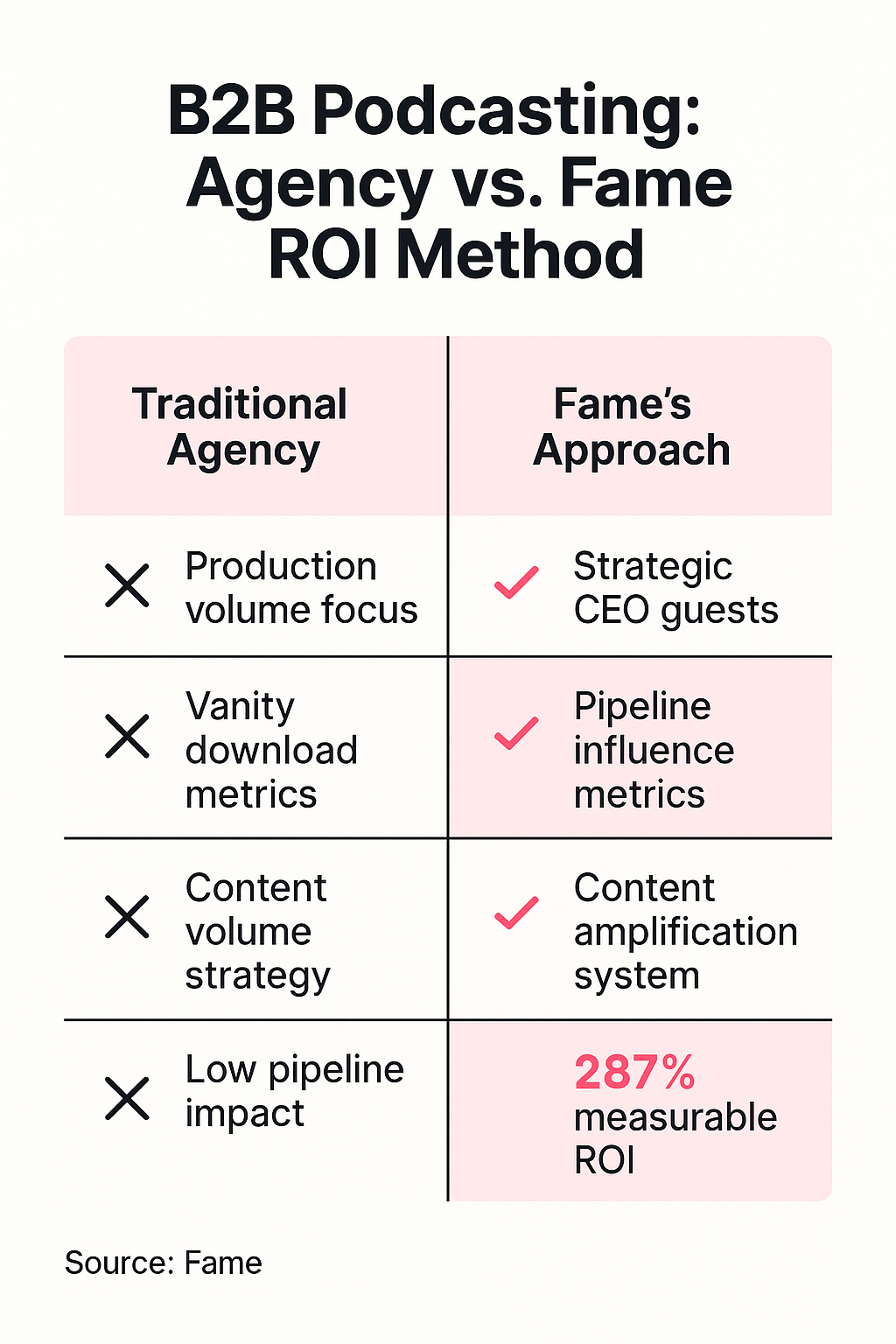
Traditional agencies focus on production efficiency; Fame engineers business outcomes. Where they see content creation, we see relationship acceleration. Where they track vanity metrics, we measure pipeline influence. Our clients don't just launch podcasts, they build category authority that compounds quarterly.
Client Result: A cybersecurity startup leveraged our Guest Association Framework to book twelve CISOs in their first season. Result? $480K in closed deals within six months, plus two strategic partnerships worth an additional $200K annually. Their "cost per acquisition" through the podcast? 73% lower than their paid search campaigns.
The real differentiator isn't our production quality, though our global team delivers that too. It's our obsession with turning podcasts into profit centers. While other agencies ask, "How many downloads?" we ask, "How much pipeline?" That shift in focus changes everything.
Fame's methodology transforms the economics of B2B podcasting. Where others see a $20K annual podcast investment as a marketing expense, we engineer it to generate immediate returns through strategic guest relationships, typically closing 1-2 deals that cover the entire investment within year one. This cash-positive ROI in year one funds the long-term audience building that drives exponential returns in years two through five.
Ready to stop playing the content game and start engineering niche fame that drives revenue? Your competitors are still counting downloads while you could be closing deals.
Transform Your Podcast From Cost Center to Revenue Engine
Most B2B podcasts fail because they measure the wrong metrics and target the wrong guests. They count downloads while deals slip through their fingers.
The strategic guest association framework changes everything. By engineering proximity to trusted voices in your market, you compress trust-building from months to minutes. Your podcast becomes a pipeline accelerator, not just another content channel.
Fame's systematic approach has helped over 100 B2B companies transform their podcasts into revenue engines. Our Guest-Fit Framework™ and Content Atomization Engine™ turn every episode into multiple touchpoints that drive measurable business outcomes. The result? Podcasts that generate positive ROI within year one and compound authority that lasts.
FAQs
How does leveraging high-value guest associations accelerate trust and authority in B2B markets compared to traditional content strategies?
Strategic guest association transfers credibility instantly, when you feature respected industry leaders, their authority becomes yours. This approach delivers 2-5x greater reach and trust amplification than generic content, with 75% of high-value guests actively sharing episodes and triggering trust cascades across their networks.
What measurable business impact can we expect from implementing a tactical guest selection framework for our B2B podcast?
Clients using a systematic guest-fit framework see pipeline velocity increase by 23% in the first quarter, with average episodes generating 2-5 qualified opportunities (vs. 0.2 from volume-based approaches). One client closed $180K in enterprise deals within 90 days, and another achieved a 35% reduction in sales cycle length.
How do we ensure our guest selection directly aligns with revenue outcomes, not just vanity metrics?
Score every potential guest against ICP overlap, audience engagement, amplification likelihood, and narrative fit; guests above a 3.5 weighted average drive pipeline, while lower scores signal vanity bookings. This method consistently delivers 12+ qualified opportunities from 20 strategic bookings and outperforms celebrity-chasing by a factor of 3.2x in pipeline conversion.
What are the key risks or challenges in scaling this approach, and how do we mitigate them?
The main risks are defaulting to high-follower 'influencers' who lack buying power, and treating guest outreach as transactional. Mitigate by targeting decision-makers with budget authority, using personalized value-driven outreach, and implementing a structured onboarding process. Clients who follow this see guest-driven downloads increase by 340% and no-show rates drop by 40%.
How do we measure and attribute ROI from guest-driven podcasting, especially in complex B2B sales cycles?
Track guest-to-pipeline conversion, deal velocity reduction, and brand trust lift using CRM integration, UTM parameters, and post-purchase surveys. The gold standard: a $20K podcast investment generating $25K+ in revenue from just one guest relationship, with pipeline influence averaging 23% and sales cycles compressing by 30-40%.
What does a successful implementation look like, and what are the first steps to get started?
Success means closing 1-2 deals that cover your annual investment within year one, building a Dream 100 guest list based on ICP and authority, and launching with a systematic outreach and onboarding process. Start by mapping your ideal customer profile, scoring potential guests, and deploying a content atomization engine to maximize every episode’s impact.

